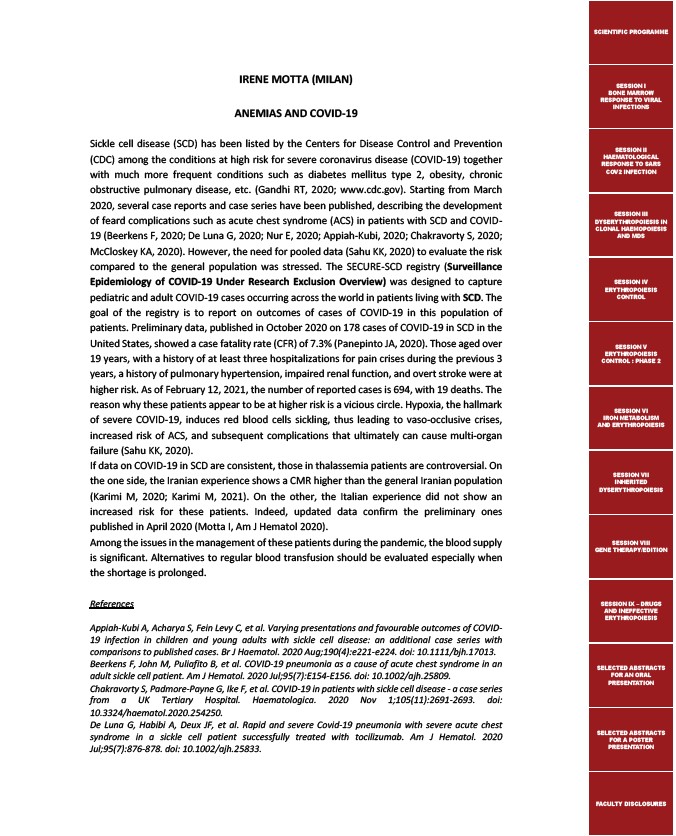
IRENE MOTTA (MILAN)
ANEMIAS AND COVID-19
Sickle cell disease (SCD) has been listed by the Centers for Disease Control and Prevention
(CDC) among the conditions at high risk for severe coronavirus disease (COVID-19) together
with much more frequent conditions such as diabetes mellitus type 2, obesity, chronic
obstructive pulmonary disease, etc. (Gandhi RT, 2020; www.cdc.gov). Starting from March
2020, several case reports and case series have been published, describing the development
of feard complications such as acute chest syndrome (ACS) in patients with SCD and COVID-
19 (Beerkens F, 2020; De Luna G, 2020; Nur E, 2020; Appiah-Kubi, 2020; Chakravorty S, 2020;
McCloskey KA, 2020). However, the need for pooled data (Sahu KK, 2020) to evaluate the risk
compared to the general population was stressed. The SECURE-SCD registry (Surveillance
Epidemiology of COVID-19 Under Research Exclusion Overview) was designed to capture
pediatric and adult COVID-19 cases occurring across the world in patients living with SCD. The
goal of the registry is to report on outcomes of cases of COVID-19 in this population of
patients. Preliminary data, published in October 2020 on 178 cases of COVID-19 in SCD in the
United States, showed a case fatality rate (CFR) of 7.3% (Panepinto JA, 2020). Those aged over
19 years, with a history of at least three hospitalizations for pain crises during the previous 3
years, a history of pulmonary hypertension, impaired renal function, and overt stroke were at
higher risk. As of February 12, 2021, the number of reported cases is 694, with 19 deaths. The
reason why these patients appear to be at higher risk is a vicious circle. Hypoxia, the hallmark
of severe COVID-19, induces red blood cells sickling, thus leading to vaso-occlusive crises,
increased risk of ACS, and subsequent complications that ultimately can cause multi-organ
failure (Sahu KK, 2020).
If data on COVID-19 in SCD are consistent, those in thalassemia patients are controversial. On
the one side, the Iranian experience shows a CMR higher than the general Iranian population
(Karimi M, 2020; Karimi M, 2021). On the other, the Italian experience did not show an
increased risk for these patients. Indeed, updated data confirm the preliminary ones
published in April 2020 (Motta I, Am J Hematol 2020).
Among the issues in the management of these patients during the pandemic, the blood supply
is significant. Alternatives to regular blood transfusion should be evaluated especially when
the shortage is prolonged.
References
Appiah-Kubi A, Acharya S, Fein Levy C, et al. Varying presentations and favourable outcomes of COVID-
19 infection in children and young adults with sickle cell disease: an additional case series with
comparisons to published cases. Br J Haematol. 2020 Aug;190(4):e221-e224. doi: 10.1111/bjh.17013.
Beerkens F, John M, Puliafito B, et al. COVID-19 pneumonia as a cause of acute chest syndrome in an
adult sickle cell patient. Am J Hematol. 2020 Jul;95(7):E154-E156. doi: 10.1002/ajh.25809.
Chakravorty S, Padmore-Payne G, Ike F, et al. COVID-19 in patients with sickle cell disease - a case series
from a UK Tertiary Hospital. Haematologica. 2020 Nov 1;105(11):2691-2693. doi:
10.3324/haematol.2020.254250.
De Luna G, Habibi A, Deux JF, et al. Rapid and severe Covid-19 pneumonia with severe acute chest
syndrome in a sickle cell patient successfully treated with tocilizumab. Am J Hematol. 2020
Jul;95(7):876-878. doi: 10.1002/ajh.25833.
SCIENTIFIC PROGRAMME
SESSION I
BONE MARROW
RESPONSE TO VIRAL
INFECTIONS
SESSION II
HAEMATOLOGICAL
RESPONSE TO SARS
COV2 INFECTION
SESSION III
DYSERYTHROPOIESIS IN
CLONAL HAEMOPOIESIS
AND MDS
SESSION IV
ERYTHROPOIESIS
CONTROL
SESSION V
ERYTHROPOIESIS
CONTROL : PHASE 2
SESSION VI
IRON METABOLISM
AND ERYTHROPOIESIS
SESSION VII
INHERITED
DYSERYTHROPOIESIS
SESSION VIII
GENE THERAPY/EDITION
SESSION IX – DRUGS
AND INEFFECTIVE
ERYTHROPOIESIS
SELECTED ABSTRACTS
FOR AN ORAL
PRESENTATION
SELECTED ABSTRACTS
FOR A POSTER
PRESENTATION
FACULTY DISCLOSURES